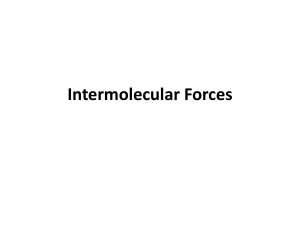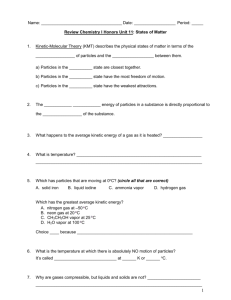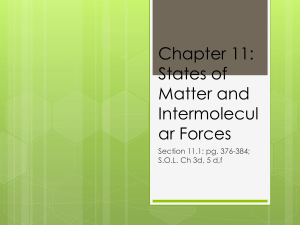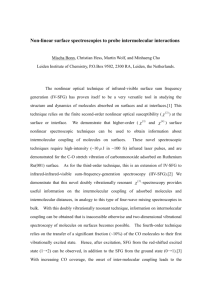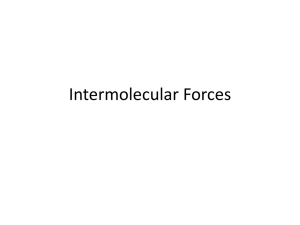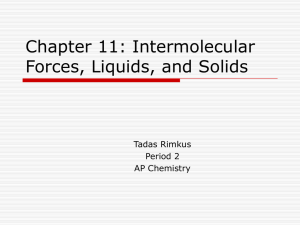Properties of Liquids Properties of Liquids and KMT Kinetic
advertisement
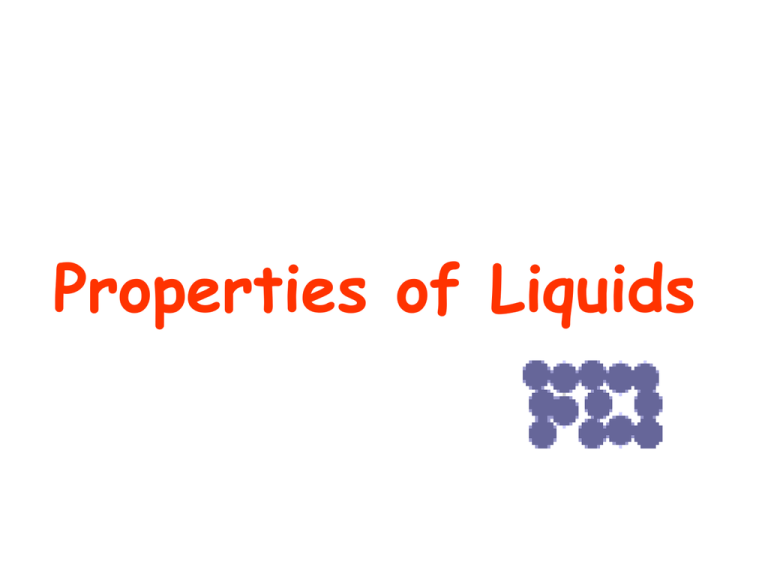
Properties of Liquids Some Characteristics of Gases, Liquids and Solids and the Microscopic Explanation for the Behavior gas liquid solid assumes the shape and volume of its container particles can move past one another assumes the shape of the part of the container which it occupies particles can move/slide past one another retains a fixed volume and shape rigid - particles locked into place compressible lots of free space between particles not easily compressible little free space between particles not easily compressible little free space between particles flows easily particles can move past one another flows easily particles can move/slide past one another does not flow easily rigid - particles cannot move/slide past one another Properties of Liquids and KMT • Kinetic-Molecular Theory (moving particle) • Fixed Volume and flexible shape • Smaller velocity Lower kinetic energy – Due to intermolecular forces – Rate of diffusion slower – What happens when we increase temperature? • Temp , Velocity , therefore, Diffusion Properties of Liquids • Particles are much closer together – Why: Attractive forces are more effective – How: Dipole-dipole, London dispersion (instant dipole) and hydrogen bonding – So? Relatively high density (more mass in a specific volume) compared to gas – More ordered than gases due to strong intermolecular forces Intermolecular Forces and the Properties of Liquids In summary, intermolecular forces play a large role in many of the physical properties of liquids. These include: • • • • vapor pressure boiling point surface tension viscosity Intermolecular Forces and the vapor pressure • The vapor pressure of a liquid depends on intermolecular forces. • When the intermolecular forces in a liquid are strong, you expect the vapor pressure to be low. Intermolecular Forces and the normal boiling point • The normal boiling point is related to vapor pressure and is lowest for liquids with the weakest intermolecular forces. • When intermolecular forces are weak, little energy is required to overcome them. • Consequently, boiling points are low for such compounds. Intermolecular Forces and the surface tension • Surface tension increases with increasing intermolecular forces. • Surface tension is the energy needed to increase the surface area of a liquid. • To increase surface area, it is necessary to pull molecules apart against the intermolecular forces of attraction. Surface Tension How are surface particles different from internal particles with respect to attractive forces? Surface Tension • The resistance of a liquid to an increase in its surface area. Surface Tension 1. Attraction of surface molecules that cause the liquid surface to contract and become more spherical 2.Amount of energy required to stretch or increase the surface Surface Tension – Common to ALL liquids – A force tends to pull adjacent parts of a liquid’s surface together – Directly related to the force of attraction between particles – Decreasing surface area to the smallest possible size – Liquid droplets are spherical • Reason: Least surface area Consequences of Surface Tension Chemistry; The Science in Context; by Thomas R Gilbert, Rein V. Kirss, and Geoffrey Davies, Norton Publisher, 2004, p 457 Consequences of Surface Tension Chemistry; The Science in Context; by Thomas R Gilbert, Rein V. Kirss, and Geoffrey Davies, Norton Publisher, 2004, p 458 http://citt.ufl.edu/Marcela/Sepulveda/html/en_tension.htm Cohesion and Adhesion Cohesion is the intermolecular attraction between like molecules Adhesion is an attraction between unlike molecules Adhesion Cohesion Cohesion/Adhesion • Why is this so? • In mercury the cohesive forces are stronger than the adhesive forces to glass. Cohesion/Adhesion • Water tends to “wet” glass because the adhesive forces between the liquid molecules and the glass molecules are greater than the cohesive forces between the liquid molecules. • Water beads up on a wax surface because the cohesive forces between the water molecules are greater than the adhesive forces between the water molecules and the wax molecules. Viscosity • The resistance of a liquid to flow is called its viscosity. • The greater a liquid’s viscosity, the more slowly it flows. • Viscosity is related to the ease with which individual molecules of the liquid can move with respect to one another. • It depends on the attractive forces between molecules. Viscosity • Viscosity decreases with increasing temperature. • Because at higher temperatures the greater average kinetic energy of the molecules more easily overcomes the attractive forces between molecules. Increasing Strength of Intermolecular Force • • • • Higher Boiling Point Lower Vapor Pressure Higher Surface Tension Higher Viscosity REFERENCES • http://www.media.pearson.com.au/schools/cw/au_sc h_whalley_sf1_1/int/matter.html • http://www.footprints-science.co.uk/states.htm • http://www.chem.purdue.edu/gchelp/atoms/states.ht ml




